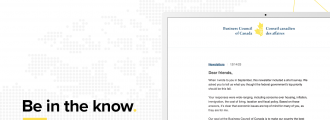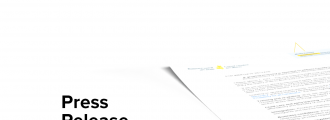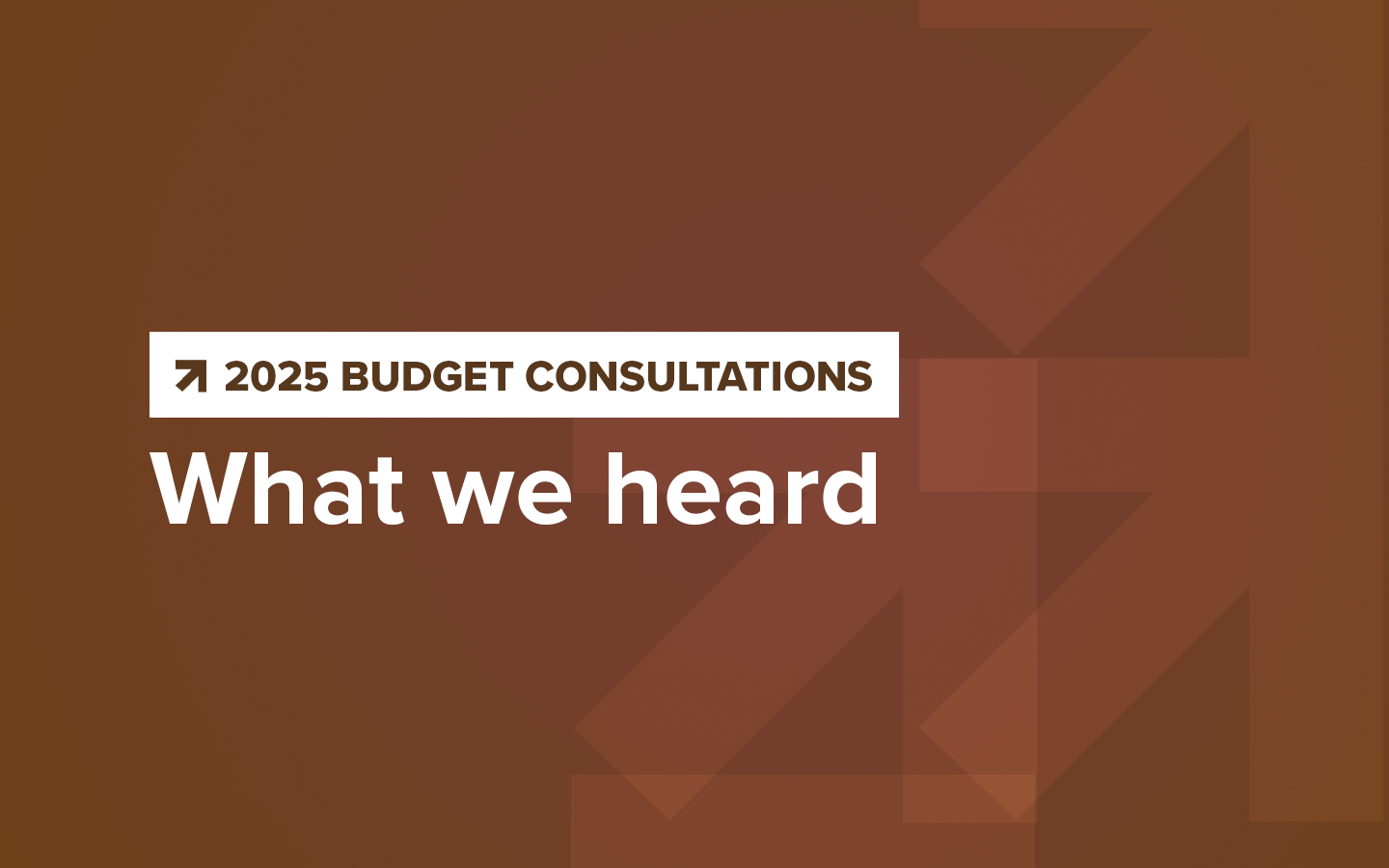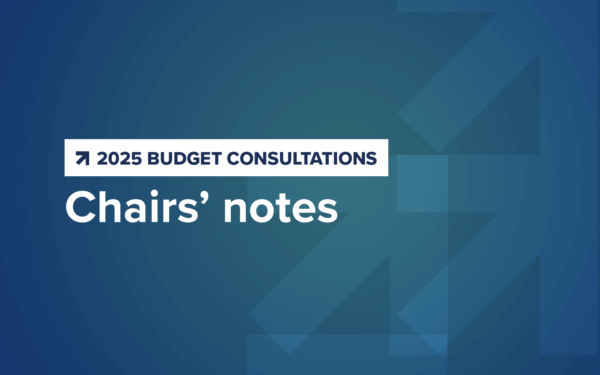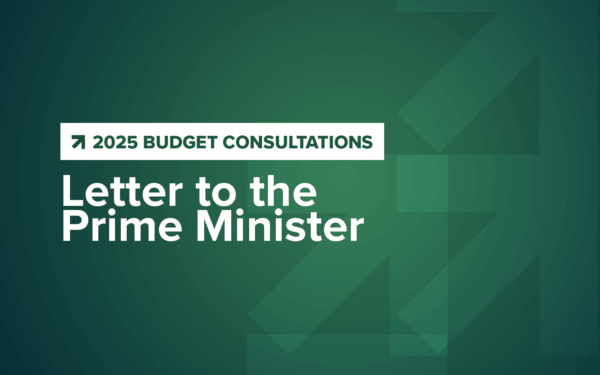What we heard
2025 Budget Consultations
Canada is now operating under a hard fiscal constraint: a larger debt stock, higher rates,
slowing global growth and mounting structural pressures. The economy is adjusting to a
fragmented world economy that is shrinking access to the U.S. market and stoking investment
uncertainty.
On November 4, Prime Minister Mark Carney’s government will update the fiscal track, build in
new commitments, and introduce changes to how the federal government approaches fiscal
planning. All indications point to much higher deficits over the next couple of years, and the
government appears intent on continuing to run deficits indefinitely to support an economy
already beginning to feel the weight of U.S. tariffs.
In that context, the Business Council of Canada (BCC) conducted an extensive consultation on
the future of the country’s fiscal policy.
A number of key themes emerged from the consultation. Here is what we heard.
(Disclosure: we used large language models to help synthesize responses.)
1) State of Federal Finances
One of the areas of consensus in our survey is that Canada right now is not facing a crisis, but the situation is extremely fragile, and the trajectory could deteriorate absent corrective action. Views converge on the same point: baseline finances were already stretched, and the next few years bring compounding pressures that will narrow room to maneuver in the medium and long term. There are widespread worries about structural slippage that erodes credibility and raises borrowing costs.
There are four main pressures on the fiscal purse:
- Legacy debt. The government inherits a larger debt stock built up over recent years, as well as the weight of new or expanded entitlement programs. Several respondents flagged imprudent budgeting practices over the past three years, particularly suspicion that some programs have been intentionally under-provisioned to show a rosier fiscal track than is likely the case. Even before new priorities, Canada’s government faces structural spending creep and a higher interest burden that crowds out fiscal space.
- Cyclical and structural headwinds. In the near term, a soft economy amid trade uncertainty will add downward pressure on revenues and activate stabilizers. Beyond the cycle, structural changes in the global trading system (fragmentation, geopolitical tensions, demographics) threaten Canada’s potential growth if not offset by productivity-raising investment. Lower trend growth with higher interest rates is a tough mix: it raises the interest-to-revenue ratio and makes consolidation both more necessary and harder.
- The Carney agenda. The new government has come into power with an ambitious investment agenda, which must be financed and delivered. While some respondents see the government’s agenda as strategically sound, everyone agrees it is fiscally non-trivial. In addition to what is expected to be very large deficits over the next two years, it appears the Carney government plans to normalize structural deficits of more than one per cent of GDP indefinitely to finance investment-related spending. This marks a pivot away from even the Trudeau government, which always at least nodded toward projecting near-balanced budgets in the medium term.
- New defence commitments to NATO. Meeting allied expectations and real security needs implies a multi-year step-up in defence outlays (capital and operating). These costs are unavoidable and compete directly with other priorities unless offsets are found. Defence pressures therefore need to be explicitly built into the fiscal anchor path, not treated as exceptional indefinitely.
According to respondents, these pressures reinforce the need for a credible fiscal framework and will force sharper choices than in the past. Put plainly, if we want to productivity-raising projects at pace, we must either spend less on lower-priority items or raise more revenue.
Risk of a downgrade. The consensus is that there is no imminent danger of a credit downgrade, but there is a significant future risk if the current fiscal trajectory is not corrected. Despite the current stability, multiple experts warn of a downgrade in the medium term. Rating agencies closely monitor adherence to debt anchors and credible medium-term frameworks. Any “slippage” could weaken the narrative and trigger a negative reaction.
Relative to peers, Canada still carries institutional credibility and market access. The issue is trajectory and shock resilience, and there is a sense that Canada’s strong reputation for fiscal credibility has eroded after the previous government repeatedly missed its own shifting anchors.
Investor demand. Despite the worrisome trajectory, there is a strong consensus among experts that there are no imminent concerns about investor appetite for Canadian government debt. Canada is still viewed as a top-tier credit relative to international peers. However, this is not seen as a reason for complacency. Experts warn that this stability relies on a reputation for fiscal discipline built in the 1990s and 2000s—a reputation that has been eroding and “can be lost quickly and without a ton of warning.”
2) The Investment Question
There is unanimous agreement on the need to increase investment in the economy to boost Canada’s lagging productivity and growth. This is seen as fundamental to long-term fiscal sustainability. Both economists and chief executives show tolerance for borrowing to finance genuine productivity-raising investments, as long as discipline is maintained within a medium-term consolidation plan.
A majority of chief executives are tolerant of higher structural deficits if they finance “economy-enhancing initiatives.” One respondent put it this way: “We need investments in productivity, market diversity, nation-building, defence and security—a significant wake-up call for the country that has been asleep for 15 years and demands near-term action.”
Experts echoed this sentiment. One investor said, “If you’re doing the kinds of things that are going to improve economic growth in the future, it’s actually a very good thing to borrow money to do that.”
At the same time, there’s recognition that the current fiscal envelope provides little room for sustained deficits, even for investment. Multiple experts note that structural deficits of more than one per cent of GDP may be inconsistent with stabilizing debt ratios given current growth and interest rate assumptions.
Operating/capital split. The proposal to formally separate the budget into operating and capital/investment components was a central point of debate. Proponents argued it makes sense to balance the operating budget while borrowing for projects that improve long-term growth.
Skeptics, particularly those with government experience, were wary. They warned of the temptation to relabel current expenditures as “investment” to escape fiscal realities, noting that “investment” can be stretched to mean almost anything. One expert called it “Spin City,” arguing that proper accrual accounting already amortizes capital costs and this would just “disguise deficits in some type of friendly way.” Another quipped, “I’m an economist that could probably justify anything except for building a gazebo.”
The median takeaway: if pursued at all, the split must rest on clear, public definitions and strong transparency. Otherwise, credibility would be at risk.
Oversight. There is support for strengthening the Parliamentary Budget Officer’s role in monitoring and stress-testing, but not for granting enforcement powers. Many noted the PBO is currently understaffed and ill-equipped, and would need significantly more resources to fulfill such a mandate.
3) Anchors and Guardrails
There was near-unanimity across all groups that fiscal anchors matter.
An overwhelming majority of chief executives and experts see anchors as extremely important—critical to ensuring political discipline, creating bureaucratic buy-in and forcing explicit trade-offs. Fiscal anchors are also closely monitored by credit rating agencies.
Dashboard approach. A majority favour a “combination” or “dashboard” of measures, arguing no single metric can capture the full picture. The debt-to-GDP ratio is the most frequently cited anchor, with most advocating a stable or declining path over the medium term. A vocal group stressed debt-servicing costs (as a share of GDP or revenue) as a better measure, since it captures the squeeze on program spending. The most hawkish respondents argued for balanced budgets or large primary surpluses, citing market credibility.
Some respondents emphasized that gross debt is a more critical measure of market risk than the often-cited net debt. Net debt can be misleading because it counts assets that are not liquid in a crisis.
Operational rules. Respondents stressed that anchors must be translated into actionable rules. Suggested examples: keep operating-spending growth below nominal GDP; publish a path of absolute deficit reductions; prohibit new permanent programs without permanent financing; and apply an investment test to capital spending.
Well-designed frameworks would combine a long-term sustainability anchor (like declining gross debt-to-GDP) with operational rules (like an expenditure cap or primary balance target), while monitoring early-warning indicators (like the debt-service ratio).
There is universal agreement that any guardrails must be flexible, applied over the business cycle, and include structured, credible escape clauses for major shocks.
4) Internal Discipline
A recurring theme is that discipline inside government has weakened since the pandemic. Revenue surprises have tended to be spent, “temporary” programs have persisted, and anchors have shifted. A common criticism of the previous Trudeau government was that it spent windfall revenues instead of investing productively.
Experts feel that the institutional “muscle memory” for fiscal restraint, forged in the 1990s, has atrophied. The result is a system where the default path is to spend.
- Spending windfalls: A key criticism is the “habit of mind” that has set in where unexpected revenue windfalls are treated as an opportunity for new spending rather than deficit reduction. As one respondent described it, “every year, you know, the numbers come in a little better than before, and then magically, you have a whole bunch of new spending you can do.” Every budget under the previous government, another expert noted, “was basically just the baseline from which they would do more spending.”
- “Temporary” programs become permanent: Experts warned of budgeting “games” that undermine fiscal credibility, such as classifying politically popular programs as temporary so their long-term costs do not appear in the fiscal track. As one respondent explained, “there’s a lot of sunset programs that get renewed every five years, and some of them have been around since the 1970s,” creating a significant and deliberately underestimated structural deficit.
To rebuild credibility, stakeholders offered up some recommendations to help force a change in behaviour and culture:
- A “First Principles” program review: The most common recommendation is a program review with teeth. This would involve asking fundamental questions of every program: Should the government even be in this space?; If so, is this something the Feds should be doing, or is it something a province could actually be doing better?; If it is a federal role, can it actually be done by a third party more efficiently than us?.
- Tactical mechanisms: To enforce day-to-day discipline, experts and members recommend stronger Treasury Board oversight, building explicit contingency reserves back into the budget, and publishing “short quarterly public scorecards” to track progress on anchors and investments.
5) Revenue vs Spending
Most experts and chief executives argue that Canada does not have a revenue problem, but a spending problem. They advocate controlling the growth of program spending. Still, some believe new spending pressures, particularly on defence, make new revenue inevitable.
The current Carney spending review was met with deep skepticism, given its limited scope.
There is no consensus on added revenue. Executives are skeptical of new taxes, preferring restraint. Experts are more open to the likelihood that additional revenue will be required.
One group of experts argued forcefully that Canada does not have a revenue shortfall. As one stated, “The U.S. has a revenue shortfall…Canada does not. Our current revenue take is in the middle of the pack.” Another concurred, noting that when looked at over the long term, revenues are “close to long-run norms” and that “one simply cannot make the case that revenues are extraordinarily low.”
The opposing camp believes new spending pressures, particularly on defence, make new revenue unavoidable. One expert was categorical: “I cannot see how the increase in defence spending to five per cent of GDP can occur without a rise in revenue”. Another argued that if society wants to maintain the current level of program spending, then “new sources of revenue are essential.”
While divided on the if, the experts were remarkably aligned on the how. If the government must raise revenue, there is an overwhelming consensus that it should use the Goods and Services Tax (GST), because it is the least distortionary option.
6) Tax reform
In addition to broad support for a comprehensive program review, there is near unanimous support for comprehensive tax reform. The current system is described as overly complex, uncompetitive, and outdated. Simplification, broader bases, and lower effective tax rates on new investment were common themes.
The call for reform is universal, with experts stating it is “long overdue”.
The priorities for reform vary, but common themes include:
- Simplification: Eliminating the many “boutique tax credits and other gimmicks that complicate the tax code”.
- Competitiveness: Lowering Canada’s “relatively high personal marginal tax rates” to discourage “brain drain” and reducing the marginal effective tax rate on new business investment.
- Reviewing tax expenditures: One expert noted that tax expenditures represent more forgone revenue than the government collects in personal income taxes and should be systematically reviewed.
Several respondents stressed that fiscal challenges cannot be separated from Canada’s broader competitiveness problem. Fiscal discipline is not an end in itself—it is a means to enable growth.
In addition to taxes, experts and members alike see regulatory barriers as “insurmountable” and a primary reason Canada has become “uninvestable”.
7) Monetary-Fiscal Coordination
A powerful consensus emerged from the expert consultations that monetary and fiscal policy should remain separate and independent, with monetary policy focused on its inflation mandate and stabilizing economic cycles, while fiscal policy should be focused on long-term growth and sustainability.
In fact, a credible fiscal policy is seen as essential to ensuring the central bank can actually do its job. This is because a key concern is the risk of “fiscal dominance,” where the central bank’s decisions become constrained by the government’s financing needs.
- Monetary policy as first responder: There is a strong view that for normal cyclical slowdowns, monetary policy should be the primary tool. As one expert argued, as long as interest rates are “not at zero yet, not even close,” we should “let monetary policy do its job first” because it is “costless” to the government’s budget and actually helps lower debt servicing costs. Broad fiscal stimulus, such as sending direct payments to households, is a tool that should be reserved for severe crises when the central bank has already cut interest rates to zero and has run out of ammunition.
- Fiscal policy for structural problems: Fiscal policy’s role is not to manage short-term demand but to address the country’s deep, long-term challenges. As one respondent explained, traditional Keynesian fiscal tools are designed to deal with “fluctuations in aggregate demand. This is not the problem. We have a big structural problem,” and policy must be oriented to fixing that.
- The core risk: Fiscal dominance is where the central bank’s primary goal shifts from controlling inflation to helping the government finance its deficits, for instance by keeping interest rates artificially low. One expert, citing the U.S. trajectory, stated that Canada needs to “avoid, charges the fiscal dominance at all costs.” It was noted that if the government runs an irresponsible fiscal policy, it can undermine and ultimately overpower the central bank. As one respondent put it: “In the end, the fiscal side dominates where you end up, and there is not a lot a central bank could do” if fiscal policy is running in a different, unsustainable direction. This is why a credible fiscal plan is seen as essential for allowing the Bank of Canada to do its job effectively.
8) Size of Government
A significant and distinct theme regarding the size and scope of government emerged from the consultations, particularly from experts with past government experience and chief executives. The consensus is that the fiscal deficit is often a symptom of a more fundamental problem: a federal government that has grown too large, inefficient, and has expanded its scope beyond its core, necessary functions.
A distinct school of thought emerged that is less focused on traditional fiscal sustainability metrics and more interested in the absolute size of government itself. One expert stated this view explicitly: “Generally speaking, I’m less motivated by measures of public finance sustainability and am more interested in measures of the size and scope of government itself—particularly how much spending growth has increased or the size of government as a share of GDP.”
For this group, the primary goal is not deficit reduction in itself, but rather to reduce the size of government to bring it in line with revenue. The preference is for a “smaller, more limited government,” with deficit reduction being a positive consequence of achieving that primary goal.
9) Overarching Advice
The consultations included open-ended comments from stakeholders on strategic imperatives for the government. The advice centered on focusing relentlessly on economic growth and demonstrating the political courage to make necessary changes.
Economic growth as the central objective: The primary advice is to shift the focus of fiscal policy from redistribution to enabling private sector-led growth. This includes aggressive regulatory reform to make Canada an attractive place to invest, building trade-enabling infrastructure, and ensuring tax competitiveness with the United States.
Address government inefficiency head-on: We heard powerful accounts of how outdated processes and a zero-risk culture have created vast inefficiencies in government operations. There is a strong belief that modernizing the public service and applying risk-based principles could unlock enormous savings.
A call for political courage and a long-term vision: A recurring theme is the need for the government to move beyond short-term political calculations. Members and experts alike call for the courage to make difficult trade-offs, to have an honest conversation with Canadians about the challenges ahead, and to implement a credible, long-term plan that looks beyond the next election cycle.


